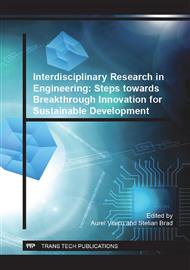[1]
L. Leocani, L. G. Cohen, E. M. Wassermann, K. Ikoma, M. Hallett Human corticospinal excitability evaluated with transcranial magnetic stimulation during different reaction time paradigms, Brain 123, pp.1161-1173, (2000).
DOI: 10.1093/brain/123.6.1161
Google Scholar
[2]
E. M. Wassermann, C. M. Epstein, U. Ziemann, V. Walsh, T. Paus, S. H. Lisanby, The Oxford Handbook of Transcranial Stimulation, 1st Edition, pp.171-200, (2008).
Google Scholar
[3]
C. Capaday, B.A. Lavoie, H. Barbeau, C. Schneider, M. Bonnard, Studies on the corticospinal control of human walking. I. Responses to focal transcranial magnetic stimulation of the motor cortex,. Journal of Neurophysiology 81, pp.129-139, (1999).
DOI: 10.1152/jn.1999.81.1.129
Google Scholar
[4]
A. Cowey, V. Walsh, Tickling the brain: studying visual sensation, perception and cognition by transcranial magnetic stimulation, Progress in Brain Research 134, pp.411-425, (2001).
DOI: 10.1016/s0079-6123(01)34027-x
Google Scholar
[5]
A. Pascual-Leone, V. Walsh, J. Rothwell, Transcranial magnetic stimulation in cognitive neuroscience - virtual lesion, chronometry, and functional connectivity, Current Opinion in Neurobiology 10, pp.232-237, (2000).
DOI: 10.1016/s0959-4388(00)00081-7
Google Scholar
[6]
A. Pascual-Leone, J. Valls-Sole, E. M. Wassermann, M. Hallett, Responses to rapid-rate transcranial magnetic stimulation of the human motor cortex, Brain 117, pp.847-858, (1994).
DOI: 10.1093/brain/117.4.847
Google Scholar
[7]
S. Bagnato, A. Curra, N. Modugno, F. Gilio, A. Quartarone, V. Rizzo, P. Girlanda, M. Inghilleri, A. Bernardellu, One-hertz subthreshold rTMS increases the threshold for evoking inhibition in the human motor cortex, Experimental Brain Research 160, pp.368-374, (2005).
DOI: 10.1007/s00221-004-2020-0
Google Scholar
[8]
F. B. Fitzgerald, T.L. Brown, Z. J. Daskalakis, R. Chen, J. Kulkarni, Intensity-dependent effects of 1 Hz rTMS on human corticospinal excitability, Clinical Neurophysiology 113, pp.1136-1141, (2002).
DOI: 10.1016/s1388-2457(02)00145-1
Google Scholar
[9]
P. B. Fitzgerald, J. Benitez, T. Oxley, J. Z. Daskalakis, A. R. de Castella, J. Kulkarni, A study of the effects of lorazepam and dextromethorphan on the response to cortical 1 Hz repetitive transcranial magnetic stimulation, Neuroreport 16, pp.1525-1528, (2005).
DOI: 10.1097/01.wnr.0000177005.14108.f1
Google Scholar
[10]
G. Heide, O. W. Witte, U. Ziemann, Physiology of modulation of motor cortex excitability by low-frequency suprathreshold repetitive transcranial magnetic stimulation, Experimental Brain Research 171, pp.26-34. (2006).
DOI: 10.1007/s00221-005-0262-0
Google Scholar
[11]
K. Kujirai, T. Kujirai, T. Sinkjaer, J. C. Rothwell, Associative plasticity in human motor cortex under voluntary muscle contraction, Journal of Neurophysiology 96, pp.1337-1346, (2006).
DOI: 10.1152/jn.01140.2005
Google Scholar
[12]
H. R. Siebner, N. Lang, V. Rizzo, M. A. Nitsche, W. Paulus, R. N. Lemon, J. C. Rothwell, Preconditioning of low-frequency repetitive transcranial magnetic stimulation with transcranial direct current stimulation: evidence for homeostatic plasticity in the human motor cortex, Journal of Neuroscience 24, pp.3379-3385, (2004).
DOI: 10.1523/jneurosci.5316-03.2004
Google Scholar
[13]
G. W. Thickbroom, M. L. Byrnes, D. J. Edwards, F. L. Mastaglia, Repetitive paired-pulse TMS at I-wave periodicity markedly increases corticospinal excitability: A new technique for modulating synaptic plasticity, Clinical Neurophysiology 117, 61-66, (2006).
DOI: 10.1016/j.clinph.2005.09.010
Google Scholar
[14]
B. Boroojerdi, Pharmacologic influences on TMS effects, Journal of Clinical Neurophysiology 19, pp.255-271, (2002).
DOI: 10.1097/00004691-200208000-00002
Google Scholar
[15]
A. Pascual-Leone, B. Rubio, F. Pallardo, M. D. Catala, Rapid-rate transcranial magnetic stimulation of the left dorsolateral prefrontal cortex in drug-resistant depression, Lancet, 348, pp.233-237, (1996).
DOI: 10.1016/s0140-6736(96)01219-6
Google Scholar
[16]
F. B. Fitzgerald, Z. J. Daskalakis, Review of Repetitive Transcranial Magnetic Stimulation Use in the Treatment of Schizophrenia,. Arch Gen Psychiatry, 60, pp.1002-1008, (2003).
Google Scholar
[17]
R. M. Berman, M. Narasimhan, G. Sanacora, A randomized clinical trial of repetitive transcranial magnetic stimulation in the treatment of major depression, Biological Psychiatry 47, pp.332-337, (2000).
DOI: 10.1016/s0006-3223(99)00243-7
Google Scholar
[18]
M. George, E. M. Wassermann, W. A. Williams, A. Callahan. T. A. Ketter, P. Basser, M. Hallet, R. M. Post Daily repetitive transcranial magnetic stimulation (rTMS) improves mood in depression, Neuroreport 6, pp.1853-1856, (1995).
DOI: 10.1097/00001756-199510020-00008
Google Scholar
[19]
R. Chen R, J. Classen, C. Gerloff, P. Celnik, E. M. Wassermann, M. Hallett, G. G. Cohen, Depression of motor cortex excitability by low-frequency transcranial magnetic stimulation, Neurology 48, pp.1398-1403, (1997).
DOI: 10.1212/wnl.48.5.1398
Google Scholar
[20]
C. Miniussi, C. Bonato, S. Bignotti, A. Gazzolli, M. Gennarelli, P. Pasqualetti, G. B. Tura, M. Ventriglia, P. M. Rossini, Repetitive transcranial magnetic stimulation (rTMS) at high and low frequency: an efficacious therapy for major drug-resistant depression?, Clinical Neurophysiology 116, pp.1062-1071, (2005).
DOI: 10.1016/j.clinph.2005.01.002
Google Scholar
[21]
F. B. Fitzgerald, J. Benitez, A. de Castella, Z. J. Daskalakis, T. L. Brown, J. Kulkarni, A randomized, controlled trial of sequential bilateral repetitive transcranial magnetic stimulation for treatment-resistant depression,. American Journal of Psychiatry 163, pp.88-94, (2006).
DOI: 10.1176/appi.ajp.163.1.88
Google Scholar
[22]
D. O. Rumi, W. F. Gattaz, S. P. Rigonatti, M. A. Rosa, F. Fregni, M. O. Rosa, C. Mansur, M.L. Mycskowski, R. A. Moreno, M. A. Marcolin, Transcranial magnetic stimulation accelerates the antidepressant effect of amitriptyline in severe depression: a double-blind placebo-controlled study, Biological Psychiatry 57, pp.162-166, (2005).
DOI: 10.1016/j.biopsych.2004.10.029
Google Scholar
[23]
H. B. Simpson, Y. Neria, R. Lewis-Fernández, F. Schneier, Anxiety Disorders: Theory, Research and Clinical Perspectives, p.330, (2010).
DOI: 10.1017/cbo9780511777578
Google Scholar
[24]
R. J. Ilmoniemi, J. Ruohonen, J. Karhu, Transcranial magnetic stimulation – A new tool for functional imaging of the brain, Critical reviews in Biomedical Engineering, 27(3-5), pp.241-284, (1999).
Google Scholar
[25]
C. Curta, S. Crisan and R. V. Ciupa, 3D Simulation Analysis of Transcranial Magnetic Stimulation, IFMBE Proceedings, Volume 36, Part 4, pp.316-319, (2011).
DOI: 10.1007/978-3-642-22586-4_66
Google Scholar
[26]
J. Ruohonen, Transcranial Magnetic Stimulation: Modeling and New Techniques, PhD Thesis, Helsinki University of Technology, Espoo, Finland, (1998).
Google Scholar
[27]
J. Moll, R. Zahn, R. de Oliveira-Souza, F. Krueger, J. Grafman, The neural basis of human moral cognition, Nature Reviews Neuroscience 6, pp.799-809, (2005).
DOI: 10.1038/nrn1768
Google Scholar
[28]
S. B. Baumann, D. R. Wozny, S. K. Kelly, F. M. Meno, The Electrical Conductivity of Human Cerebrospinal Fluid at Body Temperature, IEEE Trans. on Biomedical Engineering, Vol. 44, No. 3, pp.220-223, (1997).
DOI: 10.1109/10.554770
Google Scholar


